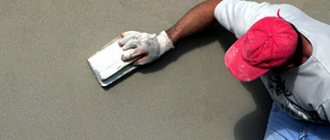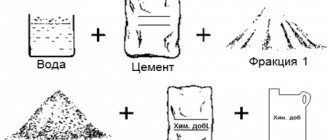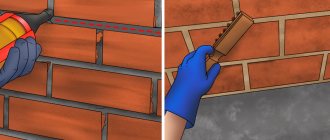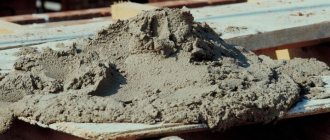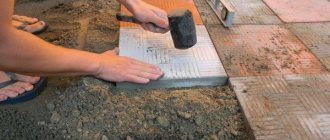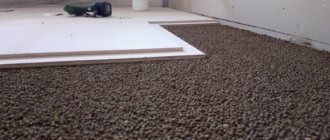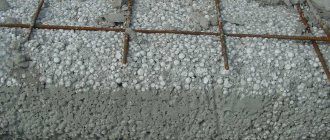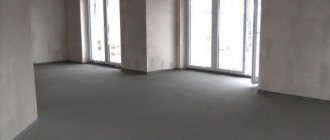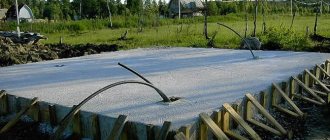In the construction industry, two types of mortar predominate - plaster and masonry. Their compositions have quite a lot of differences, but the presence of thick material remains unchanged, which contributes to the high-quality laying of bricks and blocks. Mostly masonry mortars for walls consist of lime and cement. The composition, in turn, must be sufficiently pure and not contain any impurities that could affect the quality of the material. Masonry mortar for bricks is not picky and coarse sand is used in its production, while plaster mortar does not accept coarse abrasive materials and contains only clean river sand.
Any mortar for bricks, for example, grades M25, M50 and M75 based on cement and limestone, comes in three types, according to the conditions of its use:
- a solution used for plastering walls. Classified into grades M10, M25, M50 according to GOST 28013-98;
- mortar for laying bricks. This category includes grades M50, M75, M100 according to GOST 28013-98;
- cement-lime mixture made specifically for screed. There are two types M150, M200 according to GOST 28013-98.
Composition of the mixture and its characteristics
The concrete mixture consists of several components. Four of them are mandatory:
- Water.
- Cement.
- Coarse aggregate - crushed stone.
- Fine aggregate - sand.
As necessary, special additives are introduced into concrete - antifreeze, plasticizing, gas-forming, inhibiting, catalyzing, waterproofing, pigment, increasing strength characteristics.
But all of them have limited application and are rarely used in private housing construction.
Binders and fillers
Cement is the most used type of binder in construction. This powder, produced by firing limestone and clay together, binds water to form solid compounds. Cement is not used in its pure form - it cracks when it sets. But in combination with fillers, it shows its qualities.
Cement is characterized by brand and class. The grade is the average tensile strength of a sample from the standard composition of a mixture prepared on the basis of cement, and the class is the guaranteed strength of such a sample.
The grade of concrete that is obtained when using cement depends on the characteristics of both the binder itself and the water-cement ratio, which is the basis for calculating the composition of concrete.
The filler most often is crushed limestone, although in some cases granite is used. Sand serves as a fine aggregate. There are certain requirements for their quality. Thus, they should not contain clay particles, organic contaminants, or chemical impurities. Before mixing, all this must be removed by washing the aggregate.
Parameters of ready-made formulations
The mixing of concrete is calculated in advance, because the characteristics of the finished structure will depend on the proportions of the components. These include the following parameters:
- concrete grade;
- frost resistance;
- water permeability;
- workability;
- hardening time.
The class of the resulting concrete can be assessed later, after 28 days.
But it is possible and even necessary to plan for appropriate strength. If you plan to concrete a structure using a concrete pump, you should consider ensuring that the concrete has a good cone settlement, that is, it is mobile. Otherwise, the pump will either not work or become clogged.
Compliance with technology
When mixing concrete yourself, you should follow the rules for preparing the mixture and laying it. You also need to remember about creating conditions for hardening, especially if this is done in hot, dry or, on the contrary, frosty weather. The sequence of actions during kneading will be as follows:
- Measure out the required amount of ingredients.
- Pour water into the concrete mixer.
- Add all the cement there.
- If it is planned to introduce an additive, then it is added to the water-cement mixture.
- Pour sand and crushed stone into the mixture.
- Mix thoroughly until smooth.
After mixing, the concrete must be checked with a trowel or shovel. It should not delaminate or contain unmixed lumps of sand or cement. It is not advisable to add more water as this will reduce the strength.
The concrete is placed into the formwork immediately. You shouldn’t take long breaks, so it’s better to fill large structures with ready-mixed concrete from a mixer. During installation, the poured mixture must be vibrated. There are special tools for this - vibrators. Small volumes can be compacted with a shovel or knocked on the formwork with a hammer. Failure to comply with this rule will reduce the quality of the concrete - air bubbles will form in it, which will negatively affect the strength and other characteristics of the hardened concrete.
Leveling mixture Brozex M-200 Screed, 25kg
Description Mixture for the primary leveling of concrete subfloors.
Layer thickness 10-60 mm
Made from Portland cement, natural mineral fillers and polymer additives.
INTENDED FOR: BROZEX SCREAD M-200 is used for the initial leveling of the subfloor, making a screed and creating a preparatory layer for subsequent leveling of surfaces with self-leveling solutions. Recommended as a final leveling layer before laying ceramic and stone tiles, linoleum or parquet. Used in residential and public buildings on foundations made of cement-sand mortar or concrete. The mixture is not suitable for use in underfloor heating systems.
SURFACE PREPARATION: The base must be sufficiently durable, thoroughly cleaned of dust, old paint, grease and oil stains. Weak and peeling areas of the base must be removed. Large cracks and depressions in the base should be repaired with the same solution one day before the main work. Treat the surfaces of the bases with a primer in one or several layers (depending on the absorbency) to increase the adhesion strength of the solution to the base. During work and over the next 3 days, the base temperature should be in the range from +10°C to +25°C.
METHOD OF APPLICATION: Pour the dry mixture into a container with clean water at a temperature of 18-20°C, in a ratio of 3-3.5 liters per 25 kg bag (0.13-0.15 liters per 1 kg of mixture) and mix thoroughly using a drill with an attachment until obtaining a homogeneous mass without lumps. Excess water leads to a decrease in the strength characteristics of the solution! The prepared solution must be used within 30-40 minutes. Apply the prepared mortar mixture to the base and level it using a metal ruler or rule. For final leveling and smoothing, use a spatula. Leveling the base should be done in one layer of 10-60 mm along the beacons, which are installed level in increments of 1.5-2 m. When carrying out work and during the hardening period, it is necessary to avoid drafts and prevent direct sunlight from hitting the surface of the laid mortar. The time it takes for the solution to gain strength depends on temperature and humidity. Walking on the leveled surface is permitted no earlier than 12 hours after application (subject to temperature and humidity conditions). The resulting base is not recommended for use without a floor covering. Laying tiles is permitted no earlier than 48 hours after applying the screed.
PRECAUTIONARY MEASURES: The mixture contains cement, so work must be carried out with rubber gloves. To protect the respiratory tract, use a respirator or gauze bandage. In case of contact with eyes, rinse immediately with plenty of water.
STORE in a dry place in a tightly closed container. Shelf life 6 months.
TECHNICAL DATA:
Composition: high-quality cement, natural mineral fillers, polymer additives.
| Layer thickness | 10-60 mm |
| Consumption of dry mixture at a layer thickness of 10 mm | 18-19 kg/m2 |
| Water consumption per 1 kg of dry mixture | 0.14 l/kg |
| Time to use the prepared solution | 30-40 min |
| Compressive strength of the mortar, 28 days | not less than 20 MPa |
| Maximum particle size | 3.2 mm |
Preparation and proportions
For those wishing to prepare concrete themselves, we recommend using the tables. Although there are fairly simple formulas for calculating the composition, it is unlikely that anyone will use them - after all, not all people do construction every day. Therefore, a table of concrete proportions per 1 m³ will be very useful.
Tabular data
In the literature you can find various recommendations for calculating proportions. Some give them in mass fractions, others in volume fractions, but more often both are used. For example, here is a universal table:
| M concrete | M cement | crushed stone size, mm | cement, kg | cement, liters | sand, kg | sand, l | crushed stone, kg | crushed stone, l | water, l |
| 100 | 300 | 40 | 242,16 | 220,97 | 760 | 528 | 1132 | 839 | 208 |
| 100 | 300 | 20 | 257,3 | 234,09 | 760 | 704 | 1117 | 827 | 208 |
| 150 | 300 | 40 | 302,7 | 275,4 | 680 | 472 | 1211 | 816 | 211 |
| 150 | 300 | 20 | 322,88 | 293,62 | 671 | 465 | 1200 | 889 | 211 |
| 200 | 300 | 40 | 354,16 | 321,87 | 665 | 463 | 1173 | 869 | 205 |
| 200 | 300 | 20 | 378,38 | 344,07 | 640 | 444 | 1173 | 869 | 208 |
| 150 | 400 | 40 | 237,12 | 216,94 | 1165 | 532 | 1132 | 833 | 205 |
| 150 | 400 | 20 | 253,26 | 229,04 | 760 | 528 | 1123 | 831 | 208 |
| 200 | 400 | 40 | 282,52 | 257,3 | 751 | 521 | 1111 | 823 | 208 |
| 200 | 400 | 20 | 302,7 | 275,46 | 680 | 472 | 1211 | 896 | 211 |
| 300 | 400 | 40 | 414,7 | 376,36 | 655 | 455 | 1125 | 833 | 211 |
| 300 | 400 | 20 | 443,96 | 403,6 | 620 | 431 | 1131 | 837 | 211 |
| 150 | 500 | 40 | 201,8 | 176,58 | 811 | 563 | 1191 | 881 | 211 |
| 150 | 500 | 20 | 273,44 | 184,65 | 811 | 563 | 1180 | 881 | 200 |
| 200 | 500 | 40 | 247,21 | 214,92 | 755 | 524 | 1132 | 839 | 208 |
| 200 | 500 | 20 | 262,34 | 229,04 | 715 | 497 | 1175 | 871 | 211 |
| 300 | 500 | 40 | 383,42 | 333,98 | 660 | 459 | 1151 | 852 | 211 |
| 300 | 500 | 20 | 363,24 | 315,82 | 720 | 500 | 1111 | 889 | 211 |
| 400 | 500 | 40 | 438,92 | 382,41 | 625 | 435 | 1131 | 837 | 211 |
| 400 | 500 | 20 | 459,1 | 299,56 | 615 | 427 | 1115 | 827 | 211 |
Composition of concrete M-200
The mixture for work is prepared on the basis of Portland cement grade M400 or M500: the product is optimally suited for preparing mortar for foundations and masonry work. Cement is mixed with water and aggregates of fine and coarse fractions are added: the first type includes sand with a particle diameter of up to 3-3.5 mm, and the second type includes crushed stone or gravel measuring 50-60 mm. These components give the material the required level of ductility and hardness.
Aggregates require sieving before adding to the solution to remove foreign components and impurities.
The crushed stone added must have a rounded particle shape; flat stones are rejected. The water used for the solution must have a minimum content of salts and sulfates, and the acidity level is reduced. There are also various auxiliary components that are added to the composition of M200 concrete; The table of plasticizers allows you to compare the properties of substances. The purpose of such additives is to increase the basic characteristics of the mixture (frost resistance, strength, resistance to heaving, temperature fluctuations, etc.).
The composition of M200 concrete is determined by the requirements of GOST 26633-2012; this standard specifies the types of material, classes, minimum content of various components in the composition and quality assessment criteria.
Preparation of concrete using the example of grade M400
To prepare any brand, it is recommended to take M500 cement, which is also included in the composition of M200 concrete. We need 20 buckets of cement; as for sand, according to the table, 1.6 kg is needed for the composition of 1 m3. Multiply 20 by 1.6 and get 32 buckets of sand. We perform the same operation with crushed stone - 64 buckets (1 cubic meter of concrete requires 3.2 kg of crushed stone). You need 10 buckets of water to prepare M400 concrete (20 multiplied by 0.5). As you can see, calculating the composition of M400 concrete using a table will be quite simple.
Application area
M200 solution is used for the following purposes:
- Creation of monolithic strip, pile and slab foundations for residential buildings and public buildings.
- Construction of sidewalks and garden paths.
- Production of curb stones.
- Construction of stone stairs, including those with interspan platforms.
- Production of FBS blocks and road slabs.
- Pouring floor screed, installing self-leveling floors.
The main advantage of the product is considered to be a good level of strength of finished structures with relatively rapid hardening of the solution. Key Features:
- Compressive strength – 159 kg per square centimeter.
- Water permeability varies within W4-20 and depends on the components for preparing concrete M 200, the ratio of water and solid particles.
- Mobility – 5-20 centimeters.
- Density – 1500 kg, the indicator depends on the proportions per 1m3.
When manufacturing reinforced concrete products or constructing foundations, reinforcing elements are added to concrete. They enhance the rigidity of the structure and increase the level of permissible load.
Types of solutions
Let's consider the main brands of cement mortars.
Brand M25 and M50
The cheapest and easiest to prepare options are solutions of grades M25 and M50 according to GOST 28013-98. The composition of this lime mixture is quite standard and includes all the necessary substances such as water and filler. To increase wear resistance and improve the characteristics of M25 concrete, plasticizers are added during its production, which increase the setting time of the material, and also ensures a complete absence of delamination. Having such technical characteristics, mortars of grades M25 and M50 in accordance with GOST 28013-98 for brick can guarantee absolute structural strength and resistance to poor conditions, including heavy rainfall.
Brand M75
If you are in doubt about which mortar is best to choose for laying bricks, it is recommended to pay attention to cement mixtures M75, M50 and M25. Combined with high strength, this material has excellent waterproof qualities. It is very difficult to prepare this type of lime mortar at home.
This is explained by the fact that its production uses very thorough mixing, which can only be achieved using special equipment. Weather conditions can also affect the condition of cement. It is highly not recommended to lower the temperature during the period when hardening occurs. In turn, high temperatures can cause all the moisture from the solution to evaporate too quickly, thereby making the concrete brittle.
The main technical characteristics of this brand include:
- amazing moisture resistance;
- resistance to extremely low temperatures;
- mobility.
Brand M75
Along with cement grade M 75 according to GOST 28013-98, cement grade M 100 is also widely popular. Just like M75 and M50, this mortar can be classified as masonry. However, in terms of technical characteristics it is much better. The main quality that distinguishes this product from others is its exceptional water resistance.
Mortar grade m 100 is widely used in the construction of both civil buildings and in the construction of industrial facilities. Another feature of the m 100 solution is that there is no crushed stone in this cement-lime composition. Only special sand for construction needs that meets all quality standards in accordance with GOST can act as a filler.
Proportions of components per cubic meter
You should determine the exact ratio of components in the mixture before making grade 200 concrete with your own hands. For a cubic meter of product you will need the following volume of ingredients:
- Portland cement - 330 kg (volume will be 0.25 cubic meters).
- Gravel - 1250 kg (0.9 cubic meters).
- Sand – 600 kg.
- Water – 180-190 l.
In total, the volume of the components will be 1.7 cubic meters, but in practice this amount produces 1 m3 of concrete, since smaller particles are placed in the voids between the stone and create a uniform substance without air bubbles. The proportions of grade 200 concrete may depend on a number of nuances:
- Purpose. To arrange the foundation, less water will be required, since the viscosity should be increased; liquid is required only to moisten the cement and sand. If the material is prepared for brick or stone masonry, the ratio of cement and ASG for concrete M200 will be 1 to 4. For a self-leveling floor, the ratio of components will be 1 to 3.
- Exposure to weather conditions. If there is a risk of precipitation, the ratio is also reduced to 1 to 3.
- Brand of cement. For example, the proportions of M200 concrete from M400 cement are 1 to 2.8 to 4.8: this means that per kilogram of cement there are 2.8 kg of sand and 4.8 kg of gravel or crushed stone. As a rule, the tables calculate indicators per 10 liters of cement composition. The proportions of M200 concrete from M500 cement will be different: 3.5 sand and 5.6 crushed stone are required per 1 kg.
Properties and characteristics
M-200 is the most popular material in the field of private construction.
It is a rolling stock consisting of 4 main components, which are mixed in a certain ratio:
- cement (binder);
- crushed stone (filler);
- sand (filler);
- water.
If crushed stone is not used, such a solution is called cement (sand concrete). The M200 grade ensures the reliability of buildings without forming cracks, sets quickly, does not settle, has low thermal conductivity and does not lose its properties at temperatures from +5 to +350º C. The main advantage is strength.
To obtain high-quality material, it is necessary to carefully observe the proportions of all components. By adhering to the optimal ratio, it is not difficult to obtain a mixture of good quality while reducing cost. As the grade of cement increases, its quality also improves, therefore, the consumption of cement to produce a solution with a volume of 1 cubic meter decreases. The ratio of cement, crushed stone, sand and water, for example, for the construction of a foundation, is 1: 4: 2: 0.5. It depends on the brand, the properties of crushed stone and sand, the use of plasticizers, etc. Factories take into account several dozen parameters. The grades vary from 50 to 1000, indicating the ultimate compressive strength of a cube with a 20 mm edge after 28 days. Concrete hardens intensively in the first week (up to 70%).
Table of proportions of components
It is important to know that it is advisable to add cement to the solution with an accuracy of 1 kg, crushed stone - with an accuracy of 5 kg. It is not recommended to add the entire volume of liquid, since each kneading requires a little less or more water. In order to obtain a solution of better consistency, water must be added gradually.
Water is an important ingredient in the mixture; without it it is impossible to prepare the solution and set it. It is advisable to use only clean water, free from debris and soil.
Proportions in buckets
If you need to prepare a small amount of the mixture, for example, for private construction, laying paths or finishing walls, you can measure the proportions in buckets; for M200 concrete they can be as follows:
- The weight of a bucket of portlant cement is approximately 13 kg with a volume of 10 liters, a bucket of sand - 16, gravel of the same volume - 17 kg.
- With a bucket volume of 12 liters, the weight of cement is 15.6, sand – 19.5, crushed stone – 20.5 kg.
In kilograms, the ratio of components for cement grade 400 will be 1 to 2.8 to 4.8, and for grade 500 – 1 to 3.5 to 5.6. The mobility of the mixture depends on the amount of water; liquid must be added gradually to smoothly achieve the solution of the desired consistency. In practice, they often take 2 buckets of water, 10 liters each, mix with 2 buckets filled to the top with cement, then add 3.5 buckets of sand and twice as much gravel. This ratio will allow you to get 120 liters of concrete with reduced mobility.
The volume of water depends on the purpose of the mixture and the required characteristics. The greater the amount of liquid, the less thick the concrete will be. The most viscous mixture is required when creating monolithic structures; a more liquid solution is suitable for finishing.
Having determined the proportions in buckets before preparing M200 concrete from M500 cement, you can begin mixing.
How to do it yourself?
Making concrete is possible in two ways - manually and in a concrete mixer. Manual kneading instructions:
- Pour sand into a clean container of the required volume.
- Pour Portland cement on top, mix the dry mixture until a substance is uniform in color and consistency.
- Pour water into the container, mix, add liquid in small portions until a viscous mass or liquid solution is obtained, depending on the purpose of the material. The finished mixture should not contain lumps or undissolved clumps of cement/sand.
- Add gravel or crushed stone to the concrete and mix until the stones are evenly distributed. The mixture can be diluted with a small amount of water to increase plasticity.
The manual method is cheap, does not require the use of special equipment, and is used when there is no electricity at the site. However, the technology is very labor-intensive, so it is used mainly for the preparation of small volumes of concrete products (private construction, amateur production of reinforced concrete products, production or repair of paving slabs, paths).
If you need to prepare a large amount of solution, it is advisable to use a concrete mixer. Equipment can be purchased or rented; the production procedure is as follows:
- Pour water into the drum, add cement and mix slowly until gray cement laitance appears. After this, the drum should spin non-stop.
- Add sand and crushed stone inside and mix for 3-4 minutes.
- At the end, add another 1-2 liters of water to create optimal viscosity and uniform consistency. The finished solution can be used for finishing or pouring into formwork.
Material consumption for floor screed
Let's start with the choice of cement. The heavier the finishing coating will be used and the higher the load on it, the higher grade of cement should be chosen. For apartment renovations, office premises and public institutions, we recommend choosing a brand no lower than M-400. Depending on the brand of cement, its consumption will also vary. The approximate consumption per cubic meter of the finished mixture of grade M-200 will be:
- M400 – 350 kg;
- M500 – 250 kg.
Calculating cement consumption
Depending on the area that we need to fill (or rather the total volume), the consumption of materials will directly depend. So let's start by calculating the volume. That is, if we plan to fill 100 square meters of surface (total area of the apartment) with a screed thickness of 6 cm, then the planned total volume of the solution will be equal to 100x0.06 = 6 m3. That is, it is easy to calculate that if we use M500 cement, we will need 250x6 = 1500 kg of cement. Based on 50 kg in a bag, it turns out to be a little more than 30 bags.
We count the amount of sand, water and fiber
Since semi-dry floor screed also includes sand, water and fiber, we need to calculate their quantity. Sand should be used only washed 1st class with minimal admixtures of clay, natural humidity and a coarse fraction equal to 2.2-3mm. Taking into account the shrinkage of sand equal to a coefficient of 1.15, then 1.15x6 = 6.9 m3 of sand is needed for 6 m3 of the finished mixture. Water consumption is 120 liters per 1 m3 of mixture, so the entire volume will take about 800 liters. Fiber fiber consumption is from 0.7 to 1 kg per cubic meter of solution.
Calculation for 1m2
Of course, you are unlikely to find the place and time to fill 100 m2 of an apartment yourself at once. But, guided by the above calculations, you can easily recalculate the consumption of semi-dry screed per 1 m2 (taking into account a thickness of 6 cm) - simply divide all values by 100. Well, to calculate how much mixture and materials are needed to fill 1 cm of thickness - divide everything by 6.
Tips for preparing the mixture
It is best to prepare the filling solution in small portions - based on the volume of the available container. First, thoroughly mix the dry mixture, and then gradually add water to it, without ceasing to stir. Try to use freshly prepared solution as quickly as possible. If it starts to dry out, add a little water and mix thoroughly. Do not use a solution that has been sitting for a long time.
